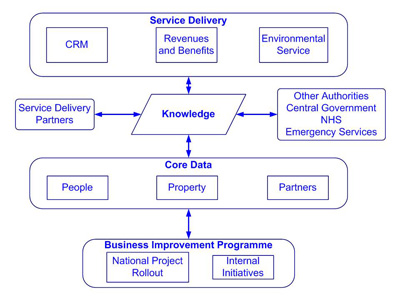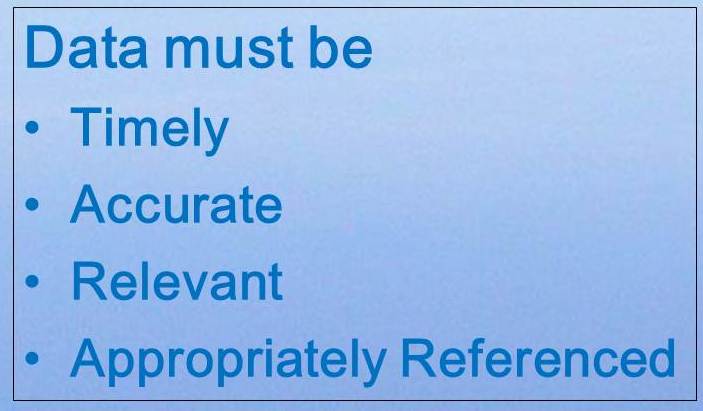Knowledge Management and Data Management
Here we focus on information management a core aspect of corporate strategy and project management. Every organisation has to ensure that its data is accurate, up to date and secure, but for maximum effectiveness and efficiency also needs to share it with its partners, customers and others.
Some background
Barry Tuckwood first wrote about data management in 1989 for an international conference on civil engineering, his main theme being efficiency improvements through shared information. This was a preview of what is now called, some 20 years later, Building Information Management and Building Information Modelling.
From 2003-7 he managed a national programme, Valuebill, funded by central government. The programme’s success required a fundamental change in the way property data was gathered and shared, with wide implications for Local Authorities, the Valuation Office Agency, and the associated software application suppliers. This involved all English and Welsh Local Authorities contributing to financial improvements through improved collection rates perhaps amounting to over £500 million since 2003.
In conjunction with the Valuation Office Agency, Barry conducted a strategic review of their data gathering processes to enable them to improve service delivery to their customers, the Local Authorities throughout England and Wales. This changed the ways in which data was obtained and shared by Local Authorities and the VOA with significant time savings in service delivery.
For these programmes he has presented and facilitated on data management at events throughout the UK.
In 2010 he ran workshops at three conferences for GP Practice Managers, noting that in construction, property management and the health service data management is complicated and getting it right is crucial to cost savings and organisational efficiency.
The following is based on presentations made and material provided for the above programmes and conferences.
Data Management
Referring to the diagram below, service delivery, regardless of sector or industry, depends on the wisdom of the people, who must have real knowledge of what they are doing based on information sourced from data. That data, the very basis of all that the organisation represents, must be timely, accurate and appropriately referenced. Many assignments and projects aim to improve the quality of the data that an organisation uses, the speed at which it can be obtained, and the certainty that it relates to the task in hand.

In this chart, used often during workshops for the project, we depicted the primary objective of the organisations as the provision of high quality services to their customers. To achieve this they needed certainty as expressed through knowledge, developed in conjunction with their partners and related organisations. These are in turn based on information gleaned from core data. Any improvement programme would therefore enable enhancement of the data at the root of this information and knowledge, and of the processes used for gathering and disseminating that data. Better data, gathered and used more effectively, leads to service improvement. Accurate, timely, relevant data is crucial for effective and efficient service delivery.
Data is provides the basis for information, beyond which we can follow the sequence through knowledge to wisdom. Whatever service we provide depends on the quality of the data we receive, retain and maintain; how that is used as information; the knowledge we have for which we use it; and the wisdom we are able to apply when we use it dependent also on our individual experience.

Referring to the diagram on Context, regardless of sector or industry, our organisation’s services depend on the wisdom of the people we work with. They must have real knowledge of what they are doing based on information sourced from data. That data, the very basis of all that the organisation represents, must be timely, accurate, relevant and appropriately referenced. It has to be available at the right time for the user, and, whatever format the data is in, it must be comprehensible to the user, as well as being complete and unambiguous. If the data does not fulfil these criteria we are at risk of creating a different and unwelcome chain:
So data must be timely, accurate, relevant and appropriately referenced.
Timely
This means that it has to be available to the people who need it when they need it. We should also recognise that data is time-bound: it might only be correct at a particular moment, often requiring verification at the time it is used.
Accurate
Data accuracy is a problem whether the data is hard or soft, by which we mean:
|
Hard data
|
Soft data
|
|
· Physical, eg location
|
· Opinion
|
|
· Factual
Historically evidential
Scientifically provable
|
· Judgment
|
|
· Clearly measured
We used the clinic scales that were calibrated on 15 February 2010
|
· Probability based
People of that height, weight and age are x% at risk of a heart attack
|
We are all accustomed to dealing with both types of data, assessing it according to our own understanding and experience. While the above example may be realistic, in his book, Bad Science, Ben Goldacre has much to say on the use and interpretation of data. I think a major point in the book is that it is easy to be misled into believing something, as in the case of the MMR scare, if we do not understand the research, the science and the statistics.
Relevant
Here we mean it must be relevant to the user whether they are creating the data or using it later. As an example, something that is stamped with a date and time is only useful if the person who reads it can relate it to their own location. USA and Europe have different time zones and also have different ways of stating the date. A logical computer-based system might use another, for example:
2011 03 12 06 15 15 could start with the year and work down to the second
03 12 2011 might mean 3rd December of March 12th.
If someone is not sure, they might be very late – or early – for their meeting.
Appropriately Referenced
Here As in the above example, if the context is known the data is easier to understand.
All industries and many organisations have their own range of terms and abbreviations intended to make life easier for the professionals. We would not want to be burdened by saying everything in full when an abbreviation is adequate.
If the reader or listener does not understand the abbreviation, acronym or term, the opportunity for error is increased, so if we are to be understood we must ensure that we properly explain the terms and descriptions for the users.
Meeting Organisational Needs
How could your organisation benefit from improvements to data management? Is your customer data fit for purpose? Do you know enough about your suppliers and orders? Do you have more than one list of addresses?
If you would like to talk about any of the issues raised here, please ask.


